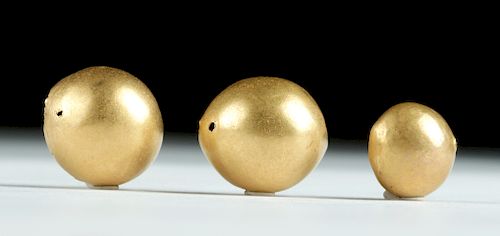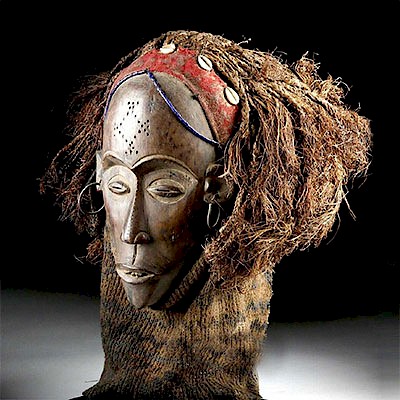Lot of 3 Moche Gold Hollow Hemispheres - 2 g
Lot 87e
About Seller
Artemis Gallery
686 S Taylor Ave, Ste 106
Louisville, CO 80027
United States
Selling antiquities, ancient and ethnographic art online since 1993, Artemis Gallery specializes in Classical Antiquities (Egyptian, Greek, Roman, Near Eastern), Asian, Pre-Columbian, African / Tribal / Oceanographic art. Our extensive inventory includes pottery, stone, metal, wood, glass and textil...Read more
Estimate:
$600 - $900
Absentee vs Live bid
Two ways to bid:
- Leave a max absentee bid and the platform will bid on your behalf up to your maximum bid during the live auction.
- Bid live during the auction and your bids will be submitted real-time to the auctioneer.
Bid Increments
| Price | Bid Increment |
|---|---|
| $0 | $25 |
| $300 | $50 |
| $1,000 | $100 |
| $2,000 | $250 |
| $5,000 | $500 |
| $10,000 | $1,000 |
| $20,000 | $2,500 |
| $50,000 | $5,000 |
| $100,000 | $10,000 |
| $200,000 | $20,000 |
About Auction
By Artemis Gallery
Apr 4, 2019
Set Reminder
2019-04-04 10:00:00
2019-04-04 10:00:00
America/New_York
Bidsquare
Bidsquare : Ancient / Ethnographic From Around The World
https://www.bidsquare.com/auctions/artemis-gallery/ancient-ethnographic-from-around-the-world-4003
Ancient art from Egypt, Greece, Italy and the Near East, as well as Asian, Pre-Columbian, Native American, African / Tribal / Oceanic, Spanish Colonial, Russian Icons, Fine art, much more! All categories, all price ranges... all legally acquired and guaranteed to be as described or your money back Artemis Gallery info@artemisgallery.com
Ancient art from Egypt, Greece, Italy and the Near East, as well as Asian, Pre-Columbian, Native American, African / Tribal / Oceanic, Spanish Colonial, Russian Icons, Fine art, much more! All categories, all price ranges... all legally acquired and guaranteed to be as described or your money back Artemis Gallery info@artemisgallery.com
- Lot Description
Pre-Columbian, North Coast Peru, Moche, ca. 100 to 700 CE. Three golden hemispheres comprised of 80% gold (equivalent to 18K+) - each one with a single perforation for suspension and/or attachment to embellish clothing, jewelry, or another form of visual culture. Any goldwork from the Moche is exceedingly rare, as their treasures were targeted by plunderers during Colonial times. See a discussion below regarding the scarcity of Moche goldworks as explained by Heidi King of the Metropolitan Museum of Art. Size: larger hemispheres measure .75" in diameter (1.9 cm); total weight: 2 grams
Heidi King of the Metropolitan Museum of Art in New York states in "The Art of Precolumbian Gold": "The Mochica or Moche as they are also known, built their capital in the dry, coastal valley of Moche, where the main construction was the Huaca del Sol, the so-called Pyramid of the Sun, the largest adobe structure built in Pre-Columbian South America. The great pyramid, made of over 143 million adobe bricks, was clearly visible and easily accessible during Colonial times, and it received extraordinary attentions from early treasure hunters (Bray this volume). As a result of such attentions, little of the wealth in precious metals that the Moche peoples are believed to have possessed remains in its ancient form today. Those works that do remain are all the more important because of their rarity." (The Art of Precolumbian Gold: The Jan Mitchell Collection" edited by Julie Jones. Boston: Little Brown & Company, 1985, p. 212)
Provenance: ex-private Grotte collection, Quincy, Illinois, USA
All items legal to buy/sell under U.S. Statute covering cultural patrimony Code 2600, CHAPTER 14, and are guaranteed to be as described or your money back.
A Certificate of Authenticity will accompany all winning bids.
We ship worldwide and handle all shipping in-house for your convenience.
#145012Only very slight surface wear and indentations. Otherwise excellent.Condition
- Shipping Info
-
All shipping is handled in-house for your convenience. Your invoice from Artemis Gallery will include shipping calculation instructions. If in doubt, please inquire BEFORE bidding for estimated shipping costs for individual items.
-
- Buyer's Premium



 EUR
EUR CAD
CAD AUD
AUD GBP
GBP MXN
MXN HKD
HKD CNY
CNY MYR
MYR SEK
SEK SGD
SGD CHF
CHF THB
THB














